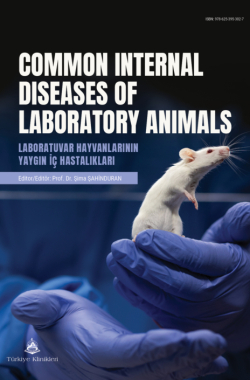Salmonellosis in Laboratory Animals
Serdar PAŞAa , Tahir ÖZALPa , Hasan ERDOĞANa
aAydın Adnan Menderes University Faculty of Veterinary Medicine, Department of Internal Medicine, Aydın, Türkiye
Paşa S, Özalp T, Erdoğan H. Salmonellosis in laboratory animals. In: Şahinduran Ş, ed. Common Internal Diseases of Laboratory Animals. 1st ed. Ankara: Türkiye Klinikleri; 2024. p.22-6.
ABSTRACT
Salmonellosis poses a major health challenge globally, due to its prevalence in humans, domestic animals, and laboratory animals, leading to significant financial and health impacts. Over 2500 serotypes have been recognized, mainly within S. enterica subsp. enterica. While clinical laboratories categorize it into six serogroups for practical purposes, comprehensive serotyping is required for precise identification, aiding in the epidemiological understanding and management of infections. The review discusses the impact of salmonellosis on laboratory animals, which despite stringent management practices, remains a concern due to the zoonotic potential of the disease and the possibility of contaminating laboratory environments. Historical data reveals a shift in the prevalence of specific serovars in lab mice, emphasizing the dynamic nature of Salmonella infections. Molecular studies have identified numerous virulence factors, highlighting the pathogen’s complexity and the need for vigilant monitoring in research settings. The impact of Salmonella extends to various laboratory animals, each presenting specific challenges and necessitating tailored management practices to mitigate the risk of outbreaks and ensure the integrity of biomedical research. This review delineates the necessity for rigorous surveillance and hygiene protocols in laboratory settings to prevent salmonellosis, underscoring the economic and health ramifications of the disease, as well as the biological complexity of the Salmonella genus.
Keywords: Diseases; animals, laboratory; salmonella
Kaynak Göster
Referanslar
- Crump JA, Luby SP, Mintz ED. The global burden of typhoid fever. Bull World Health Organ. 2004;82(5):346-53.
- Majowicz SE, Musto J, Scallan E, Angulo FJ, Kirk M, O'Brien SJ, et al.; International Collaboration on Enteric Disease 'Burden of Illness' Studies. The global burden of nontyphoidal Salmonella gastroenteritis. Clin Infect Dis. 2010;50(6):882-9. [Crossref] [PubMed]
- Popoff MY, Bockemühl J, Gheesling LL. Supplement 2001 (no. 45) to the Kauffmann-White scheme. Res Microbiol. 2003;154(3):173-4. [Crossref] [PubMed]
- Brenner FW, Villar RG, Angulo FJ, Tauxe R, Swaminathan B. Salmonella nomenclature. J Clin Microbiol. 2000;38(7):2465-7. [Crossref] [PubMed] [PMC]
- Wattiau P, Boland C, Bertrand S. Methodologies for Salmonella enterica subsp. enterica subtyping: gold standards and alternatives. Appl Environ Microbiol. 2011;77(22):7877-85. [Crossref] [PubMed] [PMC]
- Guibourdenche M, Roggentin P, Mikoleit M, Fields PI, Bockemühl J, Grimont PA, et al. Supplement 2003-2007 (No. 47) to the White-Kauffmann-Le Minor scheme. Res Microbiol. 2010;161(1):26-9. [Crossref] [PubMed]
- Centers for Disease Control and Prevention (CDC), 2012c, Multistate Outbreak of Human Salmonella Infantis Infections Linked to Dry Dog Food (Final Update) [online].
- Geller EH. Health hazards for man. In: Baker HJ, Lindsey JR, Weisbroth SH, eds. The Laboratory Rat. New York: Academic Press; 1979. p.402. [Crossref] [PubMed]
- Alexander AD. Leptospirosis in laboratory mice. Science. 1984;224(4654):1158. [Crossref] [PubMed]
- Besser TE, Gay CC, Gay JM, Hancock DD, Rice D, Pritchett LC, et al. Salmonellosis associated with S typhimurium DT104 in the USA. Vet Rec. 1997;140(3):75.
- Tauxe RV. Salmonella enteritidis and Salmonella typhimurium DT104: successful subtypes in the modern world. In: Scheld WM, Craig WA, Hughes JM, eds. Emerging Infections 3. Washington, DC.; ASM Press; 1999. p.37-52. [Crossref]
- Fookes M, Schroeder GN, Langridge GC, Blondel CJ, Mammina C, Connor TR, et al. Salmonella bongori provides insights into the evolution of the Salmonellae. PLoS Pathog. 2011;7(8):e1002191. [Crossref] [PubMed] [PMC]
- de Jong HK, Parry CM, van der Poll T, Wiersinga WJ. Host-pathogen interaction in invasive Salmonellosis. PLoS Pathog. 2012;8(10):e1002933. [Crossref] [PubMed] [PMC]
- Casebolt DB, Schoeb TR. An outbreak in mice of salmonellosis caused by Salmonella enteritidis serotype enteritidis. Lab Anim Sci. 1988;38(2):190-2.
- Tindall BJ, Grimont PAD, Garrity GM, Euzéby JP. Nomenclature and taxonomy of the genus Salmonella. Int J Syst Evol Microbiol. 2005;55(Pt 1):521-4. [Crossref] [PubMed]
- Timme RE, Pettengill JB, Allard MW, Strain E, Barrangou R, Wehnes C, et al. Phylogenetic diversity of the enteric pathogen Salmonella enterica subsp. enterica inferred from genome-wide reference-free SNP characters. Genome Biol Evol. 2013;5(11):2109-23. [Crossref] [PubMed] [PMC]
- Percy DH, Barthold SW. Hamster. In: Percy DH, Barthold SW, eds. Pathology of Laboratory Rodents and Rabbits. 3rd ed. Ames, Iowa: Blackwell; 2007. p.179-204. [Crossref]
- Percy DH. Zoonoses in laboratory animals. Can Vet J. 1987;28:268-9.
- Innes JR, Wilson C, Ross MA. Epizootic Salmonella enteritidis infection causing septic pulmonary phlebothrombosis in hamsters. J Infect Dis. 1956;98(2):133-41. [Crossref] [PubMed]
- Frisk CS. Bacterial and fungal diseases. In: Suckow MA, Stevens KA, Wilson RP, eds. The Laboratory Rabbit, Guinea Pig, Hamster, and Other Rodents. 1st ed. Waltham, MA: Academic Press; 2012. p.797-820. [Crossref]
- Brabb T, Newsome D, Burich A, Hanes M. Infectious diseases. In: Suckow MA, Stevens KW, Wilson RP, eds. The Laboratory Rabbit, Guinea Pig, Hamster, and Other Rodents. Waltham, MA: Academic Press; 2012. p.575-683. [Crossref]
- Harkness JE, Turner PV, Vandewoude S, Wheler CL. Harkness and 'Wagner's Biology and Medicine of Rabbits and Rodents. 5th ed. Ames, IA: Wiley-Blackwell; 2010.
- Misirlioglu D, Cetin C, Kahraman MM, Caner V, Ozyigit MO. Salmonella infection in a chinchilla farm. Turkish J Vet Anim Sci. 2002;26(1):151-5.
- Naglić T, Seol B, Bedeković M, Grabarević Z, Listes E. Outbreak of Salmonella enteritidis and isolation of Salmonella sofia in chinchillas (Chinchilla laniger). Vet Rec. 2003;152(23):719-20. [Crossref] [PubMed]
- Lucena RB, Giaretta PR, Tessele B, Fighera RA, Kommers GD, Irigoyen LF, et al. Diseases of chinchilla (Chinchilla lanigera). Pesquisa Vet Brasil. 2012;32(6):529-35. [Crossref]
- Jones RK, Henderson W. Isolation of Salmonella pullorum from a chinchilla. J Am Vet Med Assoc. 1953;123(918):213.
- Gorham JR, Cordy DR, Quortrup ER. Salmonella infections in mink and ferrets. Am J Vet Res. 1949;10(35):183-92.
- Rehg JE, Gigliotti F, Stokes DC. Cryptosporidiosis in ferrets. Lab Anim Sci. 1988;38(2):155-8.
- Coburn DR, Morris JA. The treatment of Salmonella typhimurium infection in ferrets. Cornell Vet. 1949;39:183-92.

